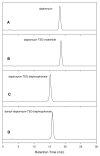Self-protecting bactericidal titanium alloy surface formed by covalent bonding of daptomycin bisphosphonates
- PMID: 20949909
- PMCID: PMC2987735
- DOI: 10.1021/bc100136e
Self-protecting bactericidal titanium alloy surface formed by covalent bonding of daptomycin bisphosphonates
Abstract
Infections are a devastating complication of titanium alloy orthopedic implants. Current therapy includes antibiotic-impregnated bone cement and antibiotic-containing coatings. We hypothesized that daptomycin, a Gram-positive peptide antibiotic, could prevent bacterial colonization on titanium alloy surfaces if covalently bonded via a flexible, hydrophilic spacer. We designed and synthesized a series of daptomycin conjugates for bonding to the surface of 1.0 cm² Ti6Al4V foils through bisphosphonate groups, reaching a maximum yield of 180 pmol/cm². Daptomycin-bonded foils killed 53 ± 5% of a high challenge dose of 3 × 10⁵ cfu Staphylococcus aureus ATCC 29213.
Figures








Similar articles
-
Covalent Attachment of Daptomycin to Ti6Al4V Alloy Surfaces by a Thioether Linkage to Inhibit Colonization by Staphylococcus aureus.ACS Omega. 2017 Apr 30;2(4):1645-1652. doi: 10.1021/acsomega.6b00567. Epub 2017 Apr 26. ACS Omega. 2017. PMID: 28474012 Free PMC article.
-
Reduced pulmonary surfactant interaction of daptomycin analogs via tryptophan replacement with alternative amino acids.Bioorg Med Chem Lett. 2012 Oct 1;22(19):6248-51. doi: 10.1016/j.bmcl.2012.08.013. Epub 2012 Aug 9. Bioorg Med Chem Lett. 2012. PMID: 22951041
-
Vancomycin covalently bonded to titanium alloy prevents bacterial colonization.J Orthop Res. 2007 Jul;25(7):858-66. doi: 10.1002/jor.20348. J Orthop Res. 2007. PMID: 17415753
-
Daptomycin: another novel agent for treating infections due to drug-resistant gram-positive pathogens.Clin Infect Dis. 2004 Apr 1;38(7):994-1000. doi: 10.1086/383472. Epub 2004 Mar 11. Clin Infect Dis. 2004. PMID: 15034832 Review.
-
[Molecular mechanisms underlying daptomycin resistance].Sheng Wu Gong Cheng Xue Bao. 2018 Jun 25;34(6):832-838. doi: 10.13345/j.cjb.170515. Sheng Wu Gong Cheng Xue Bao. 2018. PMID: 29943529 Review. Chinese.
Cited by
-
Surface-grafted zwitterionic polymers improve the efficacy of a single antibiotic injection in suppressing S. aureus periprosthetic infections.ACS Appl Bio Mater. 2020 Sep 21;3(9):5896-5904. doi: 10.1021/acsabm.0c00600. Epub 2020 Sep 2. ACS Appl Bio Mater. 2020. PMID: 34368642 Free PMC article.
-
Antibiotics- and Heavy Metals-Based Titanium Alloy Surface Modifications for Local Prosthetic Joint Infections.Antibiotics (Basel). 2021 Oct 19;10(10):1270. doi: 10.3390/antibiotics10101270. Antibiotics (Basel). 2021. PMID: 34680850 Free PMC article. Review.
-
Molecular engineering of an orthopaedic implant: from bench to bedside.Eur Cell Mater. 2012 May 24;23:362-70. doi: 10.22203/ecm.v023a28. Eur Cell Mater. 2012. PMID: 22623163 Free PMC article. Review.
-
Titanium-tethered vancomycin prevents resistance to rifampicin in Staphylococcus aureus in vitro.PLoS One. 2012;7(12):e52883. doi: 10.1371/journal.pone.0052883. Epub 2012 Dec 20. PLoS One. 2012. PMID: 23285213 Free PMC article.
-
The Potential of Surface-Immobilized Antimicrobial Peptides for the Enhancement of Orthopaedic Medical Devices: A Review.Antibiotics (Basel). 2023 Jan 19;12(2):211. doi: 10.3390/antibiotics12020211. Antibiotics (Basel). 2023. PMID: 36830122 Free PMC article. Review.
References
-
- Moss AJ, Hamburger S, Moore RM, Jr., Jeng LL, Howie LJ. Use of selected medical device implants in the United States, 1988. Adv Data. 1991:1–24. - PubMed
-
- Garvin KL, Hanssen AD. Infection after total hip arthroplasty: Past, present, and future. J. Bone Joint Surg. 1995;77A:1576–1588. - PubMed
-
- Mahan J, Seligson D, Henry SL, Hynes P, Dobbins J. Factors in pin tract infections. Orthopedics. 1991;14:305–308. - PubMed
-
- Duggan JM, Georgiadis GM, Kleshinski JF. Management of prosthetic joint infections. Infect. Med. 2001;18:534–541.
-
- Zimmerli W, Trampuz A, Ochsner PE. Prosthetic-joint infections. N Engl J Med. 2004;351:1645–54. - PubMed
Publication types
MeSH terms
Substances
Grants and funding
LinkOut - more resources
Full Text Sources
Medical
Molecular Biology Databases

